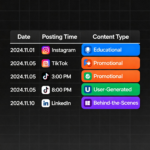
Advanced Timeline Prompts: Self-Adjusting Schedules with AI Optimization | 2025 Innovation
Advanced Timeline Prompts: Self-Adjusting Schedules with AI Optimization | 2025 Innovation
Advanced timeline prompts don’t just schedule content—they continuously analyze performance and automatically adjust posting times for maximum impact. In 2025, the most successful creators operate on self-optimizing schedules adapting to audience behavior changes in real-time.
Table Of Content
Prompt #1: “Self-Optimizing Multi-Platform Timeline”
Prompt: Copy Prompt
“Create self-optimizing content timeline automatically adjusting based on performance data: (1) Establish baseline optimal posting times based on historical audience data, (2) Implement daily performance monitoring: track engagement metrics for each post relative to posting time, (3) Weekly analysis: identify posting time variations outperforming baseline—flag for investigation, (4) Automatic adjustment: if new posting time consistently outperforms by 20%+, automatically shift future posts (with approval), (5) Seasonal recalibration: monthly analysis catching audience time-shifting (summer vacation patterns differ from winter), (6) A/B testing integration: reserve 10-15% of posts for testing new windows—if successful, integrate into primary schedule, (7) Anomaly detection: flag unusual performance spikes identifying contributing factors, (8) Generate weekly optimization reports: what changed, why, recommended adjustments, actual impact metrics. Include approval gateways maintaining your control.”

Self-optimizing timelines are the future. Rather than assuming strategy is static, you’re building systems learning and adapting continuously.
Prompt #2: “Predictive Engagement Forecasting Timeline”
Prompt: Copy Prompt
“Build predictive timeline system forecasting engagement before posting: (1) Analyze historical content performance: which content types, topics, posting times generate highest engagement, (2) Build predictive model: given specific post (topic, format, posting time), forecast expected engagement (low/medium/high), (3) Content quality scoring: automatically score drafted content predicting viral potential (hook strength, visual appeal, CTA clarity), (4) Timing optimization: for each piece, calculate three recommended posting times ranked by predicted engagement, (5) A/B schedule recommendations: suggest which content should A/B test different posting times, (6) Algorithm compatibility scoring: assess how well content aligns with current platform algorithm preferences, (7) Predictive calendar: show upcoming week with engagement forecasts for each scheduled post—identify low-predicted performers for pre-posting optimization, (8) Post-publication analysis: compare predicted vs. actual engagement continuously improving accuracy.”
Predictive systems let you optimize before publishing, not after. Catch underperforming content and strengthen it before it goes live.

Advanced Timeline Metrics
- Engagement consistency: Posts consistently hit high engagement predictions rather than random variance
- Algorithm efficiency: Less content needed for same reach through better timing
- Audience satisfaction: Posting when audiences check reduces FOMO
- Creator efficiency: Self-optimizing timelines save hours monthly
- Predictive accuracy: Forecast vs. actual engagement narrow over time
- Reach improvement: Better timing generates higher reach per post
- Audience time shift detection: System catches when audience behavior changes
“The systems that win aren’t the ones that work hardest—they’re the ones that learn fastest.” — Adaptive Systems Principle, 2025
Conclusion: From Static to Adaptive Timelines
Advanced timeline prompts transform content scheduling from fixed plans into adaptive systems continuously improving based on real-world performance. Your schedule isn’t static—it’s a living system that learns and adjusts. This is how the most successful creators operate in 2025.
Tags: advanced timeline, predictive analytics, self-optimizing, AI scheduling, adaptive systems, 2025 innovation





